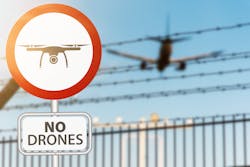Shoo, Fly! Airport's Anti-Drone System Takes on Pesky Flyers
Drones come in all sizes and even the small ones can still cause dangers when sharing the same airspace as planes.
Drones can even cause more damage than birds do when being sucked into a plane's jet engine due to their metal and plastic materials. Perhaps a bigger risk is the interference from a drone's radio frequency—possibly causing pilots to lose control of the plane.
Airports can—and have—lost money due to shutdowns caused by drones flying into their airspace. Gatwick Airport in London lost $50 million due to a security breach when a drone flew into its restricted airspace in 2018—resulting in 1,000 flights canceled with 140,000 grounded passengers.
Antaira Technologies, a developer of industrial networking devices, partnered with a Utah-based airspace security and defense company to help implement a digital, 3D-protective shield to prevent illegal drones from flying into a restricted airfield and causing an incident like the one at Gatwick Airport.
Antaira's LMX-1202G-SFP-T Gigabit-managed Ethernet switches were used inside of tall pillars surrounding the protected airspace to ensure reliable connectivity for fast response times. Antaira says that the switches link together dozens of IP video surveillance cameras, computers, and drone detection radar systems to the airport's central control station.
A combination of radar and high-resolution video, the airport's 3D shield acts as a sensor that detects unauthorized drones entering the perimeters of the airspace.
Once detected, alerts are then sent to security personnel and a protective "net drone" is automatically launched to chase down, catch, and retrieve the rogue drone(s) using a net, according to Antaira.
By using a net, the airport can prevent the rogue drone from crashing into any bystanders and prevent damage to the drone which would hinder the identification process of the operator.
Besides the high port count to connect the system's embedded computers, radar systems, and cameras, the compact, DIN-rail mountable switch offers the convenience of 30 W PoE in eight of its 12 ports to power connected devices.
Industrially hardened to withstand extreme shock and vibration, it can be safely located outdoors in an enclosure; Its operating temperature range of -40 to 167°F and IP30 protection easily handle Utah's diverse climate.
In addition, the LMX-1202G-SFP-T provides a ring network to enable the switches to communicate with each other and also with the other devices on the pillars—allowing airport security to remotely access the switches for updates or changes.
About the Author
Laura Davis
Editor-in-Chief, New Equipment Digest
Laura Davis is the editor in chief of New Equipment Digest (NED), a brand part of the Manufacturing Group at EndeavorB2B. NED covers all products, equipment, solutions, and technology related to the broad scope of manufacturing, from mops and buckets to robots and automation. Laura has been a manufacturing product writer for eight years, knowledgeable about the ins and outs of the industry, along with what readers are looking for when wanting to learn about the latest products on the market.
